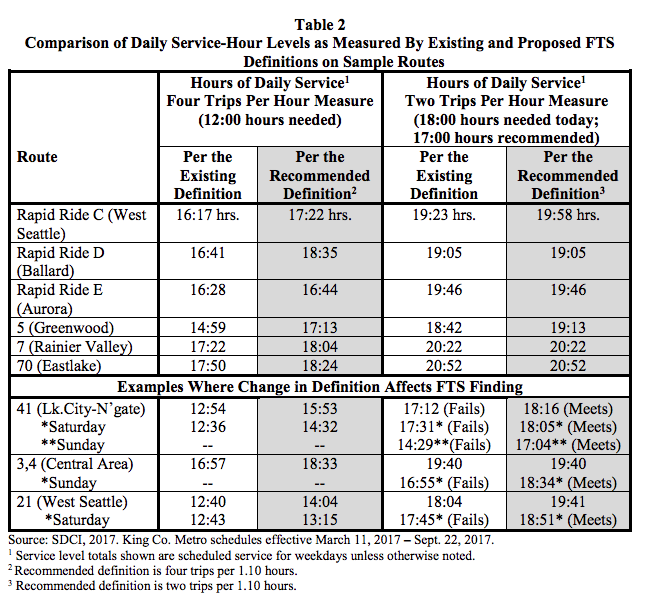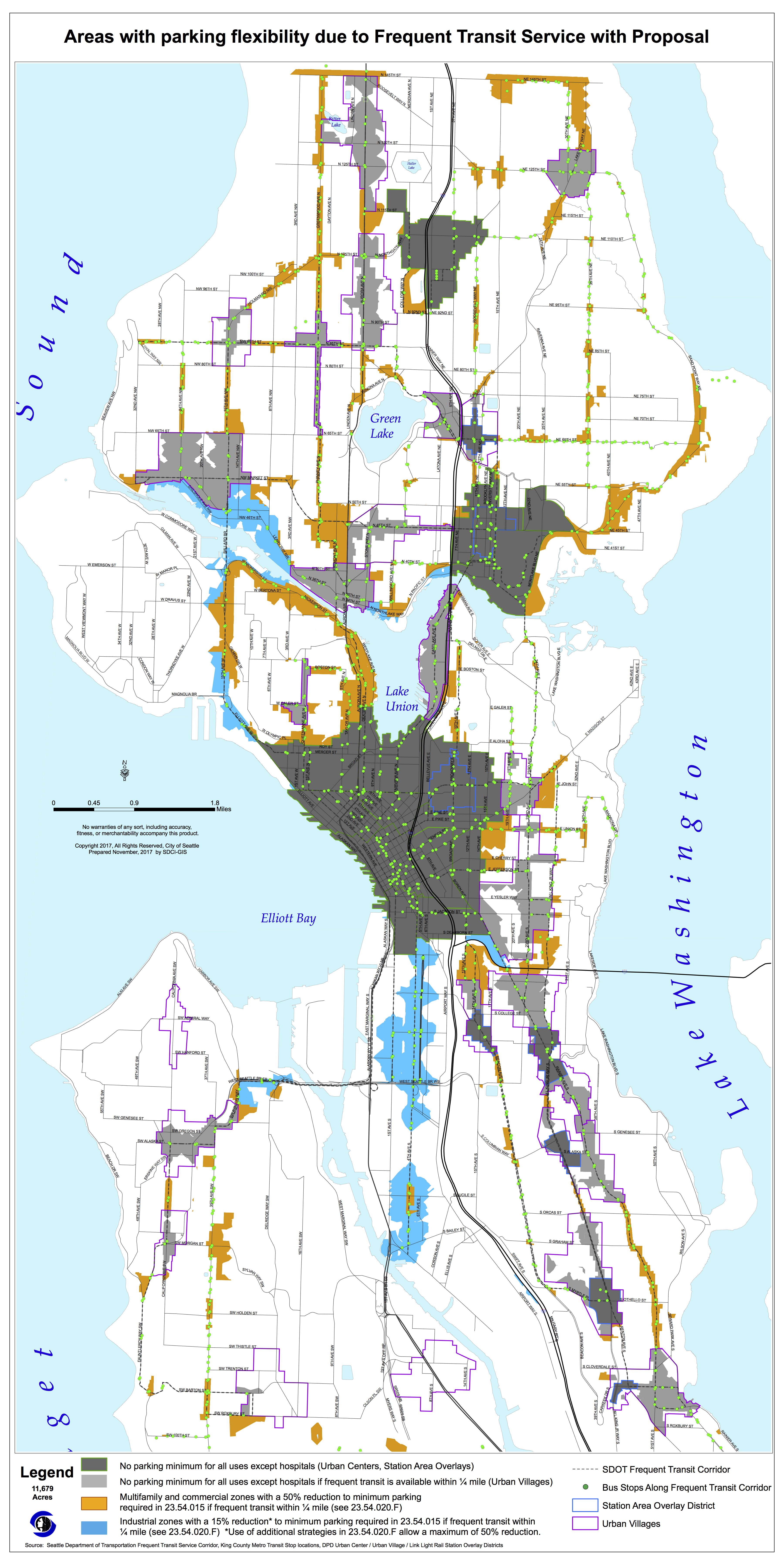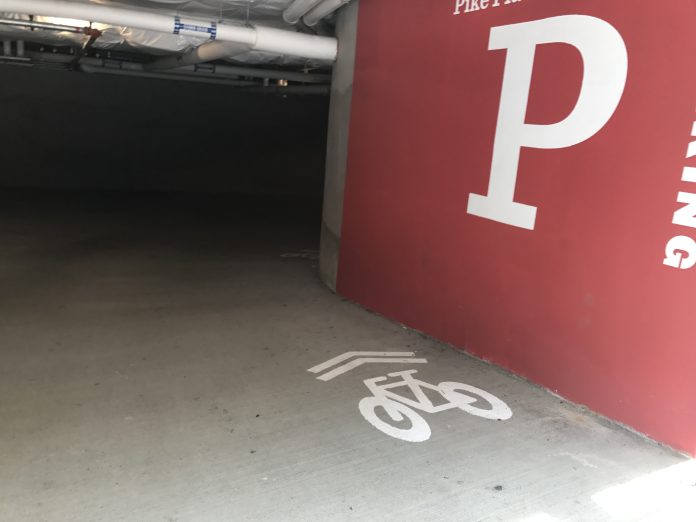Neighborhood parking reforms could soon be headed to a block near you. A suit of regulatory changes are being reviewed by the Seattle City Council that could impact how new developments provide off-street parking. The first of a handful of discussions about ways to modernize and increase flexibility of city off-street parking requirements was held by the Planning, Land Use, and Zoning (PLUZ) Committee on Wednesday. The breadth of the parking reforms are expansive including greater allowance of sharing excess parking, modifying the approach to defining “frequent transit service,” increasing bicycle parking requirements and standards, and allowing use of off-site parking up to a quarter-mile to satisfy parking requirements.
Councilmember Rob Johnson, chair of the committee, started off the discussion by noting his “I’m With Shoup” pin, a reference to parking guru Donald Shoup, before laying out the likely legislative process for the neighborhood parking reforms. The PLUZ committee will hold several meetings over the course of the next months with a public hearing on legislation in February. Separate legislation recommended by the Seattle Department of Transportation related to on-street parking reforms may also be forthcoming, which may make it desirable to temporarily hold up decisions on the neighborhood parking reform legislation, Councilmember Johnson said. Final legislation could still be approved in the March or April timeframe.
Lish Winston, a legislative analyst for Council Central Staff, provided an background on parking and driving data in Seattle, the history of off-street parking regulations, and the drawbacks of heavy off-street parking regulations. Specifically, Winston highlighted the problem problems of oversupply of parking from regulations:
- Parking requirements are often over-designed to accommodate peak parking demand that happens only a few days a year;
- Residents with garages and driveways don’t necessarily use them for parking instead using the street;
- Parking perpetuates lower density development and thereby need to drive;
- Parking areas are generally unproductive and inactive uses; and
- Parking in multi-story buildings can significantly distort the size, number, and types of dwelling constructed.
Winston also discussed the meat of the neighborhood parking reform proposal hitting the key topics addressed by it. A substantial part of the presentation involved discussion by councilmembers on the definition of “frequent transit service” and a case in West Seattle that sent shockwaves through the development community on how the definition–which allows reduced or eliminated off-street parking requirements–is applied to development proposals.
Frequent Transit Service
One of the key changes proposed in the reform package deals with frequent transit service. In many areas of the city, off-street parking requirements can be reduced or eliminated if a development proposal is located within an area with frequent transit service. This is currently defined as “transit service headways in at least one direction of 15 minutes or less for at least 12 hours per day, 6 days per week, and transit service headways of 30 minutes or less for at least 18 hours every day.”
However, the proposal would simplify the definition to “scheduled transit service defined as frequent in a Director’s rule” and add a new definition of “Transit service headway.” The primary reason for this is to solve a problem with the current definition that led the City Hearing Examiner to find that if at any period of the defined timeframe transit service can be shown to have longer intervals between service, then the stop and transit service cannot be considered as “frequent transit service.”
A draft director’s rule has already been published, which would allow frequent transit service to have variance in intervals as long as the frequency is achieved by an average. This is demonstrated in the following table:

The new rule would also map areas that are consider to be “frequent transit service areas” making it much easier for regulators, applicants, and the public to understand where off-street parking requirements can be waived or reduced. The following map shows the geographic area where that may apply:

Other Changes
Overall, the proposal is similar to the one that we covered in the fall. Urbanists, though, may not be entirely satisfied with it. Some have advocated for wider application of parking maximums in development or even absolute geographic caps on new parking and fully eliminating parking minimums. The neighborhood parking reform legislation would, however, make several other key policy changes by the definition and application of “frequent transit service.” These include:
- Adding a new parking type to the Land Use Code called “flexible-use parking.” New and existing developments would be able to allow unrestricted use of excess parking above minimum parking requirements by the general public or other developments. This would generally be allowed in the Lowrise 3, Midrise, and Highrise zones as well as most commercial and industrial zones, and in mixed-use development garages in light rail station areas.
- Making it easier to build park-and-ride garage facilities in the city, such as Lowrise 3, Midrise, Highrise, and most commercial and industrial zones.
- Capping the amount of flexible-use parking allowed in Downtown zones and eliminating an exception to exceeding parking maximums.
- Allowing more flexible use of off-site parking to meet minimum parking requirements needs in developments. Specifically, off-site parking could be located up to a quarter mille (1,320 feet) of a use, which would increase from the current maximum distance of 800 feet.
- Requiring new developments with 10 or more multifamily rental units or 10,000 square feet of new or existing commercial leased spaces to create agreements that unbundle parking. In other words, tenants would not be required to pay for parking that they do not use.
- Adjusting parking requirements (generally downward) for rent- and income-restricted housing.
- Modifying standing SEPA mitigation policies related to parking by specifying participation in a carsharing, bikesharing, or similar type of mobility program as parking impact mitigation under conditioning authority. The scope of reduced densities under parking impact mitigation would also be limited to only non-residential development when it can be shown that reduced density would result in reduced parking spillover instead of applying broadly to residential development, too.
- Increasing bicycle requirements for short-term and long-term bike parking across the board. Some of the increases are significant jumps in requirements or entirely new for specific uses. Development standards for bike parking will also generally improve with better visibility, security, design, and access requirements. Large office developments with 100,000 square feet of office space or more would need to provide changing and showering facilities for bike commuters on-site.
All in all, the changes are substantial and sweeping. As the legislation moves through the council review process, the public will have opportunities to provide feedback on how the legislation should be refined prior to adoption.
Deep Dive: SDCI’s Draft Proposal to Improve Parking Availability
Stephen is a professional urban planner in Puget Sound with a passion for sustainable, livable, and diverse cities. He is especially interested in how policies, regulations, and programs can promote positive outcomes for communities. With stints in great cities like Bellingham and Cork, Stephen currently lives in Seattle. He primarily covers land use and transportation issues and has been with The Urbanist since 2014.



